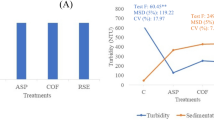Abstract
Sweet sorghum is a potential complementary crop for ethanol production in Brazil, United States and India. Since, phenols are playing inhibitory role in the process of ethanol production from extracted juice from sweet sorghum stalks, it's removal from juice is necessary for better ethanol yield. The aim of this research was to evaluate the use of magnesium oxide and calcium hydroxide as coagulant agents in different pH levels in the juice treatment. The experiment was arranged in a split-plot statistical design. Main treatments corresponded to the different coagulants and secondary treatments were the pH levels (6.0 and 7.0). Analysis of coagulant volume, juice pH, settling rate and sludge volume were performed during the decantation process. Clarified juice was analyzed as Brix, pH, ashes, phenolic compounds and starch. The use of magnesium oxide resulted in lower sludge volume, phenolic compounds and ashes. The use of calcium hydroxide decreased starch content, whereas clarification at pH 7.0 promoted higher sludge volume. Treating juice with magnesium oxide improved decantation dynamics of the process and clarified juice quality.

Similar content being viewed by others
References
Albuquerque, F.M. 2011. Processo de fabricação do açúcar. Recife: Editora UFPE.
Almodares, A., and M.R. Hadi. 2009. Production of bioethanol from sweet sorghum: A review. African Journal of Agricultural Research 4(9): 772–780.
Amorim, H.V. 2005. Fermentação alcoólica: ciência e tecnológica. Piracicaba: Editora Fermentec.
Andrzejewski, B., G. Eggleston, S. Lingle, and R. Powell. 2013. Development of a sweet sorghum juice clarification method in the manufacture of industrial feedstocks for value-added fermentation products. Industrial Crops and Products 44: 77–87.
CTC - Centro de Tecnologia Canavieira. 2005. Manual de controle químico da fabricação de açúcar. Piracicaba: Editora CTC.
Chavan, S.M.A., A. Kumar, and S.J. Jadhav. 1991. Rapid quantitative analysis of starch in sugarcane juice. International Sugar Journal 93(107): 56–59.
Ferreira, S.J., J. Kossmann, J.R. Lloyd, and J.H. Groenewald. 2008. The reduction of starch accumulation in transgenic sugarcane cell suspension culture lines. Biotechnology Journal 3: 1398–1406.
Folin, O., and V. Ciocalteu. 1927. On tyrosine and tryptophane determinations in proteins. The Journal of Biological Chemistry 73(2): 627–650.
Hugot, E. 1969. Manual da engenharia açucareira. São Paulo: Editora Mestre Jou.
Manea, V., A. Tãnase, A. Casarica, R. Albulescu, G. Rãdulescu, G. Câmpeanu, F. Israel-Roming, and G. Stoian. 2010. Study of the chemical composition of sweet sorghum stalks depleted in carbohydrates with applications in obtaining bioethanol. Genetics and Molecular Biology 14(4): 87–96.
Massey, A.R, L. Reddivari, and J. Vanamala. 2014. The Dermal layer of sweet sorghum (Sorghum bicolor) stalk, a byproduct of biofuel production and source of unique 3-deoxyanthocyanidins, has more antiproliferative and proapoptotic activity than the pith in p53 variants of HCT116 and colon cancer stem cells. Journal of Agricultural and Food Chemistry. http://dx.doi.org/10.1021/jf405415u.
Pereira Filho, I.A., R.A.C. Parrella, J.A.A. Moreira, A. May, V.F. de Souza, and J.C. Cruz. 2013. Avaliação de cultivares de sorgo sacarino [Sorghum bicolor (L.) MOENCH] em diferentes densidades de semeadura visando a características importantes na produção de etanol. Revista Brasileira de Milho e Sorgo 12(2): 118–127.
Ravaneli, G.C., D.B. Garcia, L.L. Madaleno, M.A. Mutton, J.P. Stupiello, and M.J.R. Mutton. 2011. Spittlebug impacts on sugarcane quality and ethanol production. Pesquisa Agropecuária Brasileira 46(2): 120–129.
Scheneider, F. 1979. Sugar Analysis ICUMSA methods. Peterborough: ICUMSA.
Schill, S.R. 2012. Global oil production grows at slightly higher pace than ethanol. Ethanol Producer Magazine. http://www.ethanolproducer.com/articles/8907/global-oil-production-grows-at-slightly-higher-pace-than-ethanol. Accessed 13 July 2014.
Vinutha, K.S., L. Rayaprolu, K. Yadagiri, A.V. Umakanth, J.V. Patil, and P.S. Rao. 2014. Sweet sorghum research and development in India: Status. Sugar Tech 16(2): 133–143.
Walker, G.M. 1998. Yeast physiology and biotechnology. Chichester: John Wiley and Sons.
Author information
Authors and Affiliations
Corresponding author
Rights and permissions
About this article
Cite this article
Costa, G.H.G., De Freita, C.M., De Freita, L.A. et al. Effects of Different Coagulants on Sweet Sorghum Juice Clarification. Sugar Tech 17, 210–213 (2015). https://doi.org/10.1007/s12355-014-0332-3
Received:
Accepted:
Published:
Issue Date:
DOI: https://doi.org/10.1007/s12355-014-0332-3




